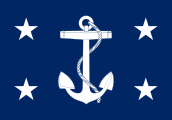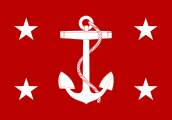J. William Middendorf
| J. William Middendorf II | |
|---|---|
.jpg) Middendorf in 1969 | |
| United States Secretary of the Navy | |
|
In office April 8, 1974 – January 20, 1977 | |
| Preceded by | John Warner |
| Succeeded by | W. Graham Claytor, Jr. |
| Personal details | |
| Born |
September 22, 1924 Baltimore, Maryland |
| Political party | Republican |
| Alma mater |
College of the Holy Cross Harvard College New York University |
| Occupation | diplomat |
| Military service | |
| Service/branch |
|
| Battles/wars | World War II |
John William Middendorf II (born September 22, 1924) is a former Republican United States diplomat and Secretary of the Navy.
Early career
John William Middendorf II received a Bachelor of Naval Science degree from College of the Holy Cross in 1945. In World War II he served in the Navy (1944-1946) as engineer officer and navigator aboard USS LCS(L) 53 in 1945. He was discharged from the Navy in 1946.
He earned a Bachelor of Arts degree from Harvard College in 1947, where he was a member of the Hasty Pudding Theatricals and the Owl Club. He also graduated from New York University's Graduate School of Business Administration, receiving an M.B.A. in 1954.
He became an investment banker and in 1963 in partnership with Austen Colgate formed his own company, Middendorf, Colgate and Company (with a seat on the New York Stock Exchange).
An early member of Barry Goldwater's presidential campaign, he served as treasurer of that campaign, and continued to have the same duties with the Republican National Committee from 1965–1969.
Government service
Shortly after taking office in 1969, Predident Richard Nixon appointed Middendorf as United States Ambassador to the Netherlands. Middendorf served in this position from July 1969 until June 1973.
After returning to the U.S., he became Under Secretary of the Navy; not long after, Secretary John Warner moved on to become head of the Bicentennial Commission, and Middendorf was told he could expect promotion to Secretary. However, when his nomination seemed to be stalled, he discovered that Secretary of Defense James Schlesinger had a candidate of his own (information that Schlesinger had not shared with Middendorf). Whereupon, Middendorf paid a personal call on many of the senators he had worked with while he was Treasurer of the Republican Party—and soon enough he had been nominated and confirmed as Secretary of the Navy, serving until the end of the Administration of President Gerald Ford. As he would later write, "Life is relationships. Politics is compromise."
During his tenure and again using his legislative contacts, Middendorf helped increase the Navy budget by 60 percent while the Army and Air Force budgets remained relatively flat. Programs he championed included the OHIO-class ballistic missile submarine and the companion Trident missile, the Aegis surface-launched missile system (which became the Navy's longest-running construction program; the 100th Aegis-equipped ship was delivered to the U. S. Navy in 2009 and systems are now in service with five allied navies). He also chamioned the F/A-18 carrier-based fighter attack aircraft—which Middendorf arranged to have dubbed "Hornet," as a tribute to his Revolutionary War ancestor merchant-shipping Captain William Stone, who donated two ships to the fledgling Navy which were then renamed "Wasp" and "Hornet." Those names survived many years and many ships, but as the fleet began to shrink and as ship-naming became more political—i.e., breaking the old rules and naming ships after living politicians—there weren't enough new candidates for traditional names.
Incoming President Carter invited Middendorf to stay on as Secretary of the Navy; however, as Middendorf noted in his 2011 memoir Potomac Fever, he told the President-elect "that it was the best job in government and therefore an insecure post for a Republican in a Democrat administration." During the Carter presidency, Middendorf was back in the private sector, as President and Chief Executive Officer of Financial General Bankshares (which he re-organized and renamed First American Bank). Next, he headed the CIA transition team (1980) for incoming President Ronald Reagan and was then named Permanent Representative of the United States of America to the Organization of American States (OAS), with the rank of Ambassador. He served in the post until 1984, when he accepted appointment as U. S. Representative to the European Community (known today as the European Union) serving until 1987.
Other pursuits and interests
In 2006 Middendorf published a book describing his work with the Goldwater campaign. Glorious Disaster: Barry Goldwater's Presidential Campaign and the Origins of the Conservative Movement details how Goldwater's campaign became the foundation of the modern Conservative movement. In 2011 he published his autobiography, Potomac Fever.
He is a prolific composer of symphonies (including the Holland Symphony, presented to Queen Juliana of the Netherlands on the 25th anniversary of her ascension to the throne) and 100 marches for ships of the U.S. Navy.
Ambassador Middendorf is a member of the board of directors of the International Republican Institute.[1] He is a member of the board of trustees for the Heritage Foundation, an influential Washington, D.C. based public policy research institute.[2]
He is also a member of the Rhode Island Society of the Sons of the Revolution and the Naval Order of the United States.
Honors and awards
Decorations and medals from the United States Government
- Superior Honor Award, U.S. Department of State, 1974
- Department of Defense Medal for Distinguished Public Service, 1975; bronze palm (second award), 1976
- Navy Distinguished Public Service Award, 1976
- American Campaign Medal
- Asiatic-Pacific Campaign Medal with two battle stars
- World War II Victory Medal
- Navy Occupation Medal with "ASIA" clasp
- China Service Medal
Foreign orders, decorations and medals
- Grand Master in Order of Orange-Nassau, The Netherlands, 1985
- Order of the Arab Republic of Egypt – Rank A (highest foreign decoration) by President Sadat
- Grand Master of the Order of Naval Merit – Republic of Brazil, 1974
- Naval Distinguished Service Medal, Brazil, 1976
Other awards
Middendorf has received the "Edwin Franko Goldman Award" from the American Bandmasters Association and is a member of the American Society of Composers and Performers (ASCAP). Other honors include:
- Hudson River Museum Honoree, Hudson River Museum, 2009
- Maritime Security Lifetime Excellence Award, 2002
- Arleigh Burke Award – Navy League of the United States, 1998
- Ludwig von Mises Free Market Award – 1985
- Distinguished Service Award, Purdue University Band
- Gold Medal, The Netherlands Society of the Sons of American Revolution
- Medal of Honor, Midwest National Band and Orchestra Association
- Alumnus of the Year, New York University Graduate School of Business
- Association of Harvard Clubs of American Award (Music) (Keogh Award)
- NYU Eugene Keogh Award for Distinguished Public Service (1989)
- American Friends of Turkey Leadership Award, 1989
- Presidential Physical Fitness Award, 1990
- Distinguished Patriot Award, SAR of State of New York, 1975
- Award of Merit, Art League of Virginia (Portrait of Del), 1996
- U.S. Olympic Committee Gold Shield Award
- Gold Medal, Holland Society of New York, 1996
- American Bandmasters Association Edwin Franko Goldman Award
- American Music Award, Harvard Clubs
Honorary degrees
- Troy State University – Doctor of Law
- School of the Ozarks – Doctor of Letters
- American Christian College – Doctor of Letters
- Francisco Marroquin University – Doctor of Social Sciences
Bibliography
- J. William Middendorf II (October 23, 2006). A Glorious Disaster: Barry Goldwater's Presidential Campaign and the Origins of the Conservative Movement. Basic Books. ISBN 978-0-465-04573-0.
References
External links
| Wikimedia Commons has media related to J. William Middendorf. |
- American paintings & historical prints from the Middendorf collection, an exhibition catalog from The Metropolitan Museum of Art (fully available online as PDF)
- Appearances on C-SPAN
| Government offices | ||
|---|---|---|
| Preceded by Frank P. Sanders |
Under Secretary of the Navy August 3, 1973 – June 20, 1974 |
Succeeded by David S. Potter |
| Preceded by John Warner |
United States Secretary of the Navy April 8, 1974 – January 20, 1977 |
Succeeded by W. Graham Claytor, Jr. |
| Diplomatic posts | ||
| Preceded by William R. Tyler |
United States Ambassador to the Netherlands July 9, 1969 – June 10, 1973 |
Succeeded by Kingdon Gould, Jr. |
| Preceded by George S. Vest |
United States Ambassador to the European Union 1985–1987 |
Succeeded by Alfred H. Kingon |


